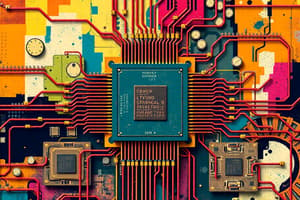Podcast
Questions and Answers
What is stored memory architecture also known as?
What is stored memory architecture also known as?
- Main memory architecture
- Stored program architecture
- Harvard architecture
- Von Neumann's architecture (correct)
Where are instructions and data stored in Von Neumann's architecture?
Where are instructions and data stored in Von Neumann's architecture?
- Data in registers, instructions in the ALU
- Data and instructions both in main memory (correct)
- Data in the CPU, instructions in main memory
- Data in main memory, instructions in peripheral devices
What does the arithmetic and logical unit (ALU) of the CPU do?
What does the arithmetic and logical unit (ALU) of the CPU do?
- Performs arithmetic and logical operations (correct)
- Generates timing signals and control signals
- Stores temporary data and intermediate results
- Controls access to registers and main memory
Which component helps reduce the burden on the main memory by storing data temporarily and intermediately?
Which component helps reduce the burden on the main memory by storing data temporarily and intermediately?
What is the main purpose of data mining?
What is the main purpose of data mining?
Which phase of the knowledge discovery process involves choosing the data and combining it into a single dataset?
Which phase of the knowledge discovery process involves choosing the data and combining it into a single dataset?
What type of patterns and knowledge discovery does data mining cover?
What type of patterns and knowledge discovery does data mining cover?
Which techniques are applied to the data warehouse in the preprocessing phase of the knowledge discovery process?
Which techniques are applied to the data warehouse in the preprocessing phase of the knowledge discovery process?
What is the earliest step in the data mining process?
What is the earliest step in the data mining process?
What is the primary focus of data mining in its earliest step?
What is the primary focus of data mining in its earliest step?
Which process is typically the first step in the knowledge discovery process?
Which process is typically the first step in the knowledge discovery process?
Flashcards are hidden until you start studying
Study Notes
- Von Neumann's architecture, also known as stored memory architecture, keeps data and instructions in the same main memory.
- Stored memory refers to the data and program being stored in memory. Data is constants and variables, while instructions are sets of commands for processing work.
- Main memory is where both data and instructions are stored. Instructions can be stored in some addresses, while data can be stored in others.
- The architecture is opposite to Harvard architecture, which stores instructions in different memory and data in different memory.
- Von Neumann's architecture includes the central processing unit (CPU), which contains the arithmetic and logical unit (ALU) and registers.
- ALU consists of various circuits, such as adders, subtractors, and shift operations, which perform arithmetic and logical operations.
- Registers are the fastest memory available, storing temporary data and intermediate results. They come in various sizes and help reduce the burden on the main memory by storing data temporarily and intermediately.
- The control unit generates timing signals and control signals, which determine the sequence of instructions to be executed and control access to registers and main memory.
- The input-output system includes peripheral devices like keyboards, monitors, and other output devices, which are connected through various buses and help input and output data to and from the main memory and CPU.
- The storage and processing of data involve calling it from the main memory to the CPU, processing it in the registers and ALU, and returning the output to the main memory for further use or storage.
Studying That Suits You
Use AI to generate personalized quizzes and flashcards to suit your learning preferences.




